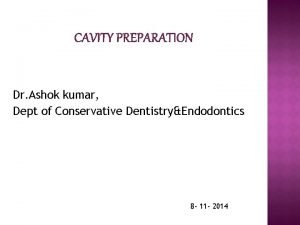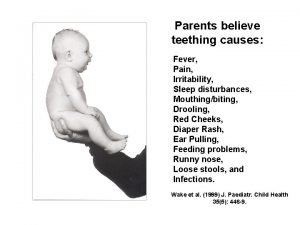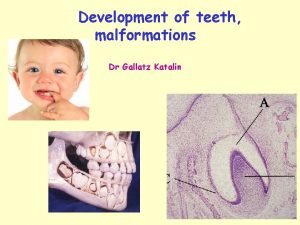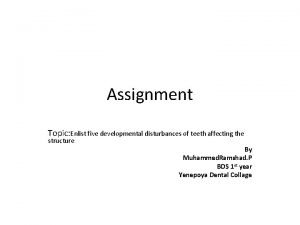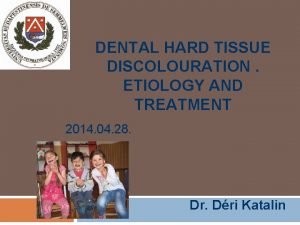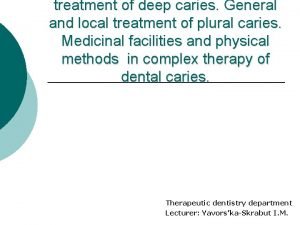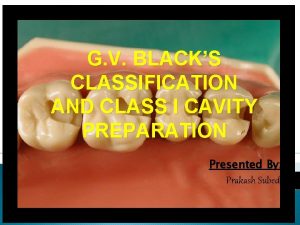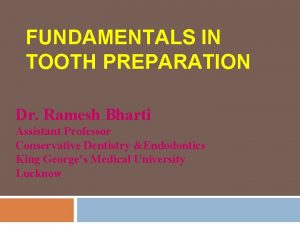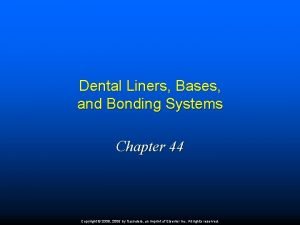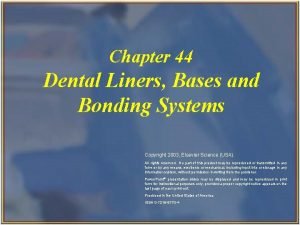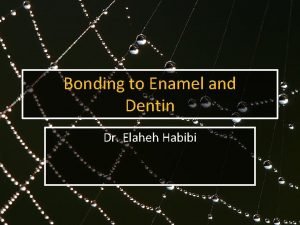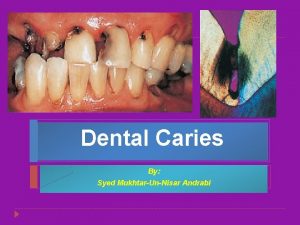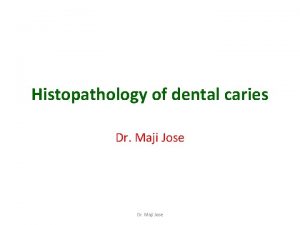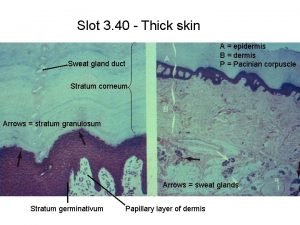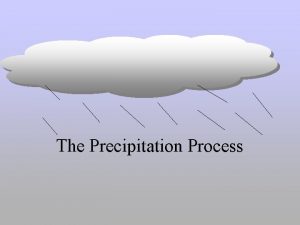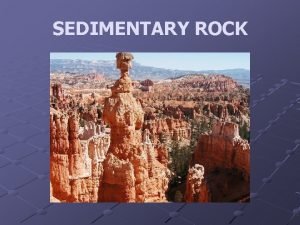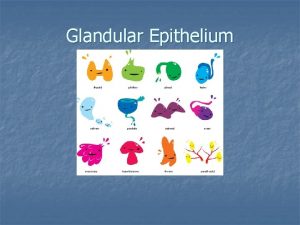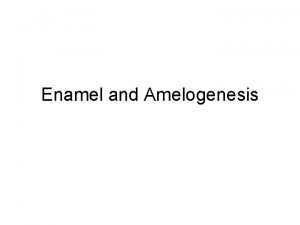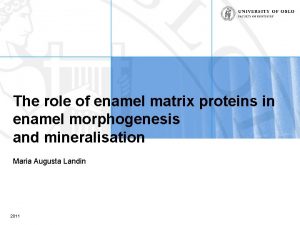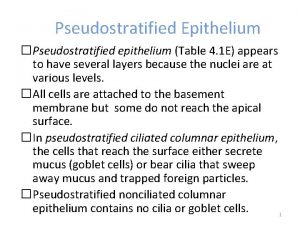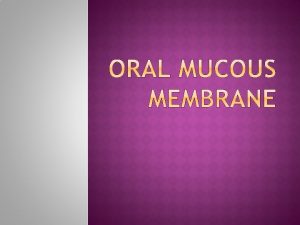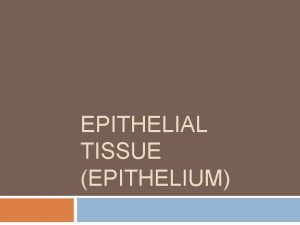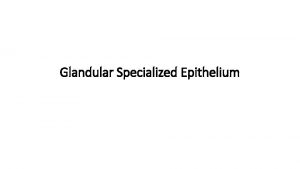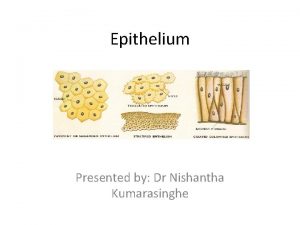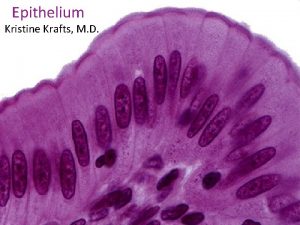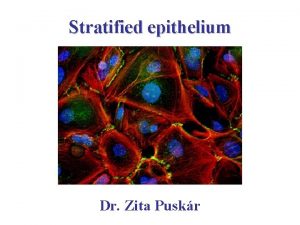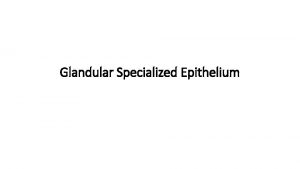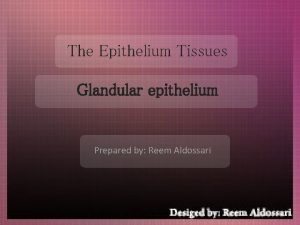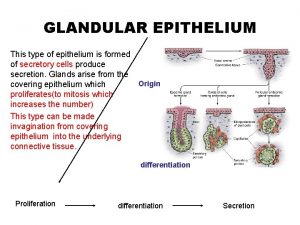Amelogenesis Process of enamel formation inner enamel epithelium








































- Slides: 40



Amelogenesis

• Process of enamel formation • inner enamel epithelium Ameloblasts • Late bell stage – cuspal region

• Secretory phase Synthesis of organic matrix Enamel Proteins Amelogenin Enamelin Sheathelin Amelin Enamelin Tuftelin • Maturation phase Final mineralisation

LIFE CYCLE OF AMELOBLAST Pre-secretory stage – Morphogenic / Morphogenetic stage – Organizing / Differentiating stage Secretory stage – Formative stage Post-secretory stages – Maturative stage – Protective stage – Desmolytic stage

1. Morphogenetic Stage • Bell stage • IEE Cuboidal / Low Columnar • Central Nucleus • Golgi Proximal • Others Scattered


Morphogenic stage • Shape of the DEJ & crown determined Cells of IEE interacts with Underlying connective tissue through differential growth Tooth Shape is determined


Reciprocal induction Ameloblast Enamel INNER ENAMEL EPITHELIUM Signaling molecules & GF Ectomesenchymal cells of dental papilla Odontoblast Dentin

2. Organising Stage • Differentiate into Ameloblasts • Elongate • N Proximal (RP) • Golgi Central • “Reversal of polarity”

Apical or proximal end Basal or distal end

Apical or proximal end Basal or distal end

Apical or proximal end “Reversal Of polarity” Basal or distal end


3. Secretory stage

Tome’s Process

Enamel Rod structure is determined by Tome’s Process


4. Maturation Stage • Ht – Ameloblast Ruffle end ameloblast Smooth end ameloblast


• Slight reduction in height • Decrease in organelle


5, Protective Stage • Flat Ameloblast • Enamel Cutilce • REE


6. Desmolytic Stage • REE Secretes • Collagenase • Hyaluronidase • Chondrotin sulfatase Disintegration of C T B/W oral epithelium & REE Fusion of Oral Epithelium & REE


IEE Tall columnar Nuclei shifted to proximal end (RP) GF from IEE Induction of differentiation of odontoblasts Odontoblasts secrete dentin Dentin crystals induce IEE Ameloblasts (“Reciprocal induction”)

Secrete Enamel Matrix Ameloblasts move away from the laid down enamel matrix Tome’s Process “Picket fence”/ “Saw tooth”appearance Enamel organ collapse ( B V becomes closer to Ameloblasts)


Enamel maturation Flat Ameloblasts + SI + SR + OEE REE Fuses with Oral epithelium Tooth erupts into the oral cavity


Amelogenesis • Two process 1. Organic matrix formation 2. Mineralization

Organic matrix formation • Enamel formation begins in the cusp tips and incisal edges → progresses outward and cervically. • In early stages of amelogenesis, the enamel matrix consists of 20 -30% proteins (amelogenin and non-amelogenin) and the proportion gradually decreases

Enamel proteins • Amelogenin – 80% • Non amelogenin 5 -20 % (crystal growth) – Enamelin – Tuftelin – Ameloblastin(ameilin & sheathlin) – Amelotin & enzymes like protienases

Mineralization • Mineralization takes place in two steps 1. Immediate partial mineralization 2. Maturation.

• Mineral deposition in enamel matrix occurs in four phases. – Primary mineralization corresponds to immediate partial mineralization (30 % of mineral deposition) – Secondary stage starts at the surface and proceeds toward DEJ – In tertiary stage, mineral rebounds from inner layer of enamel outward. – Fourth stage is responsible for further deposition of minerals in the surface enamel which makes it hypermineralized than the rest of enamel.


Maturation • This starts from the height of the crown and then gradually proceeds cervically. It begins at the dentinal end of the enamel rods. • Begins even before the matrix has formed to its full thickness. • Crystals grow in size rapidly, and the organic matrix becomes thin to make room for the growing crystals.
 Inner defender examples
Inner defender examples Undermined enamel vs unsupported enamel
Undermined enamel vs unsupported enamel Dental follicle
Dental follicle Dr gallatz katalin
Dr gallatz katalin Epithelium which protects inner part of the body is
Epithelium which protects inner part of the body is Amelogenesis imperfecta
Amelogenesis imperfecta Stages of amelogenesis
Stages of amelogenesis Amelogenesis imperfecta
Amelogenesis imperfecta Inner critic and inner defender
Inner critic and inner defender Formation initiale vs formation continue
Formation initiale vs formation continue Indication of amalgam
Indication of amalgam Cervical enamel projection
Cervical enamel projection Angle former instrument formula
Angle former instrument formula Gv black classification of cavity preparation
Gv black classification of cavity preparation Ramesh bharti
Ramesh bharti Enamel cuticle acid resistance
Enamel cuticle acid resistance Enamel niche
Enamel niche An example of enamel bonding is the placement of a
An example of enamel bonding is the placement of a Enamel composition
Enamel composition Bases in dentistry
Bases in dentistry Wet bonding vs dry bonding
Wet bonding vs dry bonding Enamel defect
Enamel defect Turbid dentin in carious tooth
Turbid dentin in carious tooth Micromechanical retention
Micromechanical retention Prognacia
Prognacia Enamel rods in gingival third of primary teeth
Enamel rods in gingival third of primary teeth Liquefaction foci dentin
Liquefaction foci dentin Enamel pulp
Enamel pulp Flare in cavity preparation
Flare in cavity preparation Enamel tufts
Enamel tufts Coronal dentin
Coronal dentin Word formation processes compounding examples
Word formation processes compounding examples Bergeron process diagram
Bergeron process diagram Process of bone formation
Process of bone formation Process of platelet plug formation
Process of platelet plug formation Coordinating marketing activities
Coordinating marketing activities Coinage in linguistics examples
Coinage in linguistics examples Pedalfers
Pedalfers Sedimentary rock formation
Sedimentary rock formation Types of morphology
Types of morphology Epithelium of urethra
Epithelium of urethra

